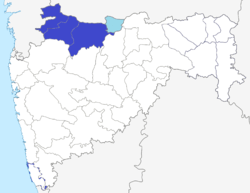Khandesh
| Khandesh खान्देश kanhadesh | |
|---|---|
| Historical region | |
|
Landscape of the Tapi River in Dhule district. | |
 Blue: Khandesh in Maharashtra Light Blue: Khandesh in Madhya Pradesh (Burhanpur) | |
| Country | India |
| State | Maharashtra and Madhya Pradesh |
| Elevation | 240 m (790 ft) |

Khandesh (Marathi: खान्देश) is a region of central India, which forms the northwestern portion of Maharashtra state.[1]
Khandesh was the region demarcated as a boundary after which Dakkhan a.k.a. Deccan started.
Originally the Khandesh state was founded and ruled by the Faruqi dynasty with the capital at Burhanpur which is now in Madhya Pradesh. Khandesh State had covered the area of the today's Dhule, Jalgaon, Nandurbar districts of Maharashtra state and Burhanpur district of Madhya Pradesh state.
The terms "Khandesh" and "Deccan" thus connote historical and political affiliations, as well as geographical zones. Khandesh lies on the Northwestern corner of the Deccan plateau, in the valley of the Tapi River, and is bound to the north by the Satpura Range, to the east by the Berar (Vidarbha) region, to the south by the Hills of Ajanta, belonging to the Marathwada region of Maharashtra, and to the west by the northernmost ranges of the Western Ghats, and beyond them the coastal plain of Gujarat.
After India's independence in 1947, Bombay province became Bombay state, which in 1960 was divided into the linguistic states of Maharashtra and Gujarat. During the formation of the State of India, Burhanpur became the part of the state Of Madhya Pradesh, and in 1960, East Khandesh became Jalgaon district, and West Khandesh became Dhule of the Maharashtra State.
The principal natural feature is the Tapi River. Unlike the rest of the Deccan, whose rivers rise in the Western Ghats and flow eastward to the Bay of Bengal, the Tapi flows westward from headwaters in southern Madhya Pradesh to empty into the Arabian Sea. The Tapi receives thirteen principal tributaries in its course through Khandesh. None of the rivers is navigable, and the Tapi flows in a deep bed which historically made it difficult to use for irrigation. Most of Khandesh lies south of the Tapi, and is drained by its tributaries the Girna, Bori and Panjhra. The alluvial plain north of the Tapi contains some of the richest tracts in Khandesh, and the land rises towards the Satpuda hills. In the centre and east the country is level, save for some low ranges of barren hills. To the north and west, the plain rises into rugged hills, thickly wooded, and inhabited by the tribal Bhil people.
History
Khandesh was ruled by the Faruqi dynasty with capital at Burhanpur, who maintained their independence from the Bahmani, which ruled much of the Deccan from the fourteenth to the sixteenth centuries.
When Mughal padshah (emperor) Akbar conquered much of the Deccan (eastern Golconda - Haiderabad- would follow suit only in 1687, under Aurangzeb), he added there three subahs (top-level imperial provinces to the initial dozen : Berar (1596), Kandesh (in 1601, renamed Danesh after his son Daniyal; capital Burhanpur) and Ahmadnagar (1601-1636; consecutively renamed Daulatabad and Aurangabad, like its capitals).

The British, only to prove their hold over regions, divided Khandesh in 1906 into two districts : East Khandesh, headquartered at Jalgaon, had an area of 4544 mi² and a population of 957,728 in 1901, while West Khandesh, headquartered at Dhule had an area of 5497 mi² and a population of 469,654 in 1901.[2]
Farmers of Khandesh are hardworking. There was no major irrigation facility in Khandesh before the Girana and Hatnur dams were commissioned. Most of the Khandesh is arid or semi arid.
Culture
Khandesh has rich cultural and literary heritage.
प्रमुख खाद्य-शेव भाजी,पूरण पोली,खिचड़ी,वांग्याचे भरित,भाकरी,कळण्याची भाकर व धपाटे, ठेचा, रोडगा (बट्टी).
Languages
Marathi is official and mostly spoken language in Khandesh. Ahirani is spoken in West Khandesh from Girana basin this language is the mix of Marathi, Gujarati, Gujar, Hindi, Kannada. Khandeshi/Ahirani is spoken in Eastern part of Khandesh.[3]
Arts
Mukta Bai, the younger sister of Dnyaneshwar, lived at Muktainagar, near which the great yogi Changdeva lived in the thirteenth century. There was also strong presence of Kabir Pantha in Khandesh due to the proximity of Burhanpur, the seat of Kabir Panth.
Bahinabai Chaudhari regarded as one the greatest poetess in Marathi literature belonged to a Khandeshi farmer family. Her son Kavi Sopandeo Choudhary was famous for his poetry with a touch of humor. Balkavi, Trambak Bapuji Thombre, then another great name in Marathi poetry belonged to Jalgaon district. Dr. V.B. Kolte a noted scholar of Marathi hailed from Khandesh who was the top authority on Mahanubhav literature.
The well known Marathi writers from Khandesh region include Dr. Bhalchandra Nemade, N. D. Mahanor and Dr. Sharad Rane. Dr. Nemade is known for his Novels Kosala, Bidhar, Jarila and Zool and collection of poetry Melody. His recent addition is Hindu.
Geographical elements
Cities
|
|
|
|
|
Rivers
- Girana
- Panjara
- Tapi
- Waghur
Dams
- Akkalpada
- Aner Dam
- Anjani Dam Erandol
- Girna
- Hatnur
- Latipada
- Nakane
- Sulwade Dam (Shindkheda)
- Waghur Dam
See also
References
- ↑ "Welcome to Khandesh!". Khandesh.com. Retrieved 2010-08-01.
- ↑ "Khandesh". Khandesh. Retrieved 2010-08-01.
- ↑ Santronix Computers pvt. Ltd. (2007-05-19). "Khandesh cultural heritage - Jalgaon, Dhule, Nandurbar lifestyle". Ejalgaon.com. Archived from the original on 20 August 2010. Retrieved 2010-08-01.
External links and sources
Coordinates: 21°N 75°E / 21°N 75°E
